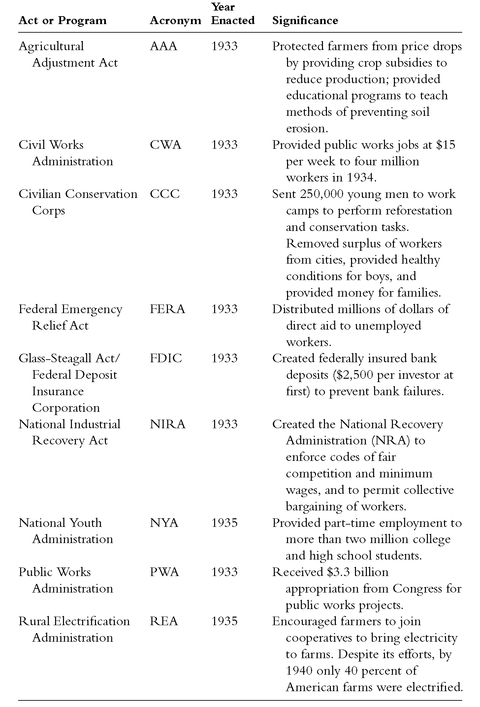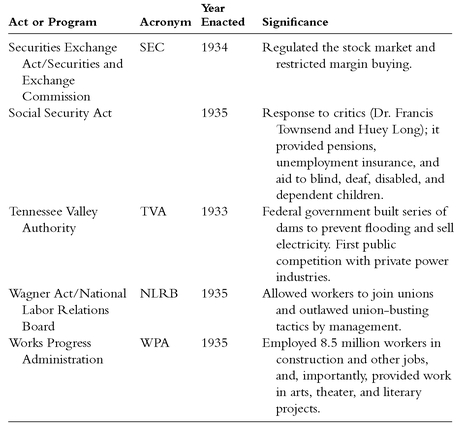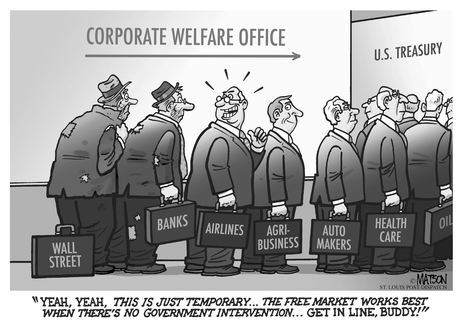Bailout Nation (7 page)
Authors: Barry Ritholtz

Table 3.1
New Deal Programs
New Deal Programs

SOURCE: Greg D. Feldmeth,
www.polytechnic.org/faculty/UShistory
www.polytechnic.org/faculty/UShistory

Unlike the current crisis, the Great Depression was not primarily located in any one sector; it was endemic to every corner of the economy. The government tried to reinvigorate the broader economy and to recapitalize the financial sector. It provided funding and a mechanism to allow homeowners who could afford to rework their mortgages to do so. The focus of the many government programs was to shore up the financial institutions. Once that was accomplished through government guaranteesâinsurance for deposits, credit availability for banksâonly then did the population start developing faith in these institutions.
Yet, there are a few parallels between today and the 1930s. Rampant speculation among Wall Street players set up the initial market crash in both eras. In both cases, the primary vehicle for leverage was unregulated credit or derivatives. Leverage added fuel on the way up, and it caught fire on the way down. Once all this liquidity began to dry up, the leverage led to a myriad of interconnected problems throughout the economy. Growth rapidly contracted. The initial government reaction was tepid, with key players mostly in denial about the extent of the economic damage. As the damage became increasingly difficult to ignore, the governmental response became broader, with major corporate bankruptcies spurring action. Then came a presidential election and new administration promising significant change.
One of the government's early responses to the crisis of the 1930s was to provide loans for railroads. The goal was to maintain the value of their bonds and therefore indirectly strengthen the banks' balance sheets. In the current era, loans to banks and brokerage firmsâinitially to keep them liquid, but ultimately to keep them solventâhas been one of the early Federal Reserve responses.
Here's a fun trick: Take any Depression-era railroad lending legislation, and place it into a document. Now do a “find & replace,” substituting the words “home mortgages” for “railroad bonds.” You very nearly end up with what became known as the Emergency Economic Stabilization Act, also known as the Troubled Assets Relief Program (TARP) passed on an emergency basis on October 3, 2008.
Current Fed chairman Ben Bernanke is a renowned student of the Great Depression, so perhaps similarities in the legislation are a bit of an homage. But Bernanke may have missed the biggest lessons of when and why massive government intervention is warrantedâor at least may have turned them on their head, as we'll see in ensuing chapters.
Chapter 4
Industrial-Era Bailouts (1971-1995)
When things are going well, the companies stress the idea of free enterprise, with no need for government regulation. But when things aren't going well, they suddenly become a close partner with the government and want it to bail them out. All they have to do is threaten to collapse and the government pours in more money.
âA. Ernest Fitzgerald, civilian cost analyst and
Management Systems Deputy to the Air Force
Assistant Secretary for Financial Management
Management Systems Deputy to the Air Force
Assistant Secretary for Financial Management
Â
Â
T
he previous era of government interventions focused broadly on emergency economic and prewar relief: Housing, jobs, finance, industrial production, and wartime preparation all received enormous aid.
he previous era of government interventions focused broadly on emergency economic and prewar relief: Housing, jobs, finance, industrial production, and wartime preparation all received enormous aid.
The era that followed took a new and different path: bailouts of individual companies. This represented an enormous break from past philosophies, government activities, and use of taxpayer proceeds.

T
he year 1971 was a sea change in the history of American bailouts. That was the year when, for the very first time, the United States bailed out an industrial firm whose own financial mismanagement had driven it to the brink of extinction. The company was Lockheed Aircraft Corporation, and the bailout was in the form of loan guarantees worth $250 million.
he year 1971 was a sea change in the history of American bailouts. That was the year when, for the very first time, the United States bailed out an industrial firm whose own financial mismanagement had driven it to the brink of extinction. The company was Lockheed Aircraft Corporation, and the bailout was in the form of loan guarantees worth $250 million.
Prior to the Lockheed rescue, the United States had never acted
in loco parentis
for any single firm. Previous rescue operations were intended to help the nation work through difficult times. During the Great Depression, one in four workers was unemployed, and the nation's economy was contracting 15 percent per year. The fear of further economic damage and civil unrest essentially forced the government's hand. During the period prior to U.S. entry into World War II, the government gave aid to steel, munitions, and rubber companies. As much as any governmental interventions, before or since, it is difficult to call these actions bailoutsâthey were acts of national self-preservation aimed at entire wartime industries, not individual private enterprises.
in loco parentis
for any single firm. Previous rescue operations were intended to help the nation work through difficult times. During the Great Depression, one in four workers was unemployed, and the nation's economy was contracting 15 percent per year. The fear of further economic damage and civil unrest essentially forced the government's hand. During the period prior to U.S. entry into World War II, the government gave aid to steel, munitions, and rubber companies. As much as any governmental interventions, before or since, it is difficult to call these actions bailoutsâthey were acts of national self-preservation aimed at entire wartime industries, not individual private enterprises.
Lockheed was an unprecedented and, to many people, alarming new development. Never before had the government effected a rescue operation of a single company.
The firm had been having financial troubles for several years, posting losses in 1969 ($19.5 million) and 1970 ($86.3 million). Management had repeatedly made significant miscalculations on major projects: The company had won a $1.9 billion defense contract for the C-5A military transport plane in 1965, underbidding Boeing by $300 million.
1
Lockheed's optimistic projections led to enormous cost overruns. Separately, the firm's attempt at building passenger aircraftâthe L-1011 TriStarâwas also problematic. On top of these, Lockheed also had cost overruns on three other large military projects.
1
Lockheed's optimistic projections led to enormous cost overruns. Separately, the firm's attempt at building passenger aircraftâthe L-1011 TriStarâwas also problematic. On top of these, Lockheed also had cost overruns on three other large military projects.
All in all, the firm was in dire financial straits due to its own actions and mismanagement.
2
2
Despite its bumbling missteps, Lockheed hadn't become the nation's largest defense contractor because its management was foolish. They may have been marginally competent when it came to managing large military projects, but their true genius lay in the procurement process. By 1971, they had learned to quite skillfully navigate the vast bureaucracy of the U.S. military. And since the majority of Lockheed's revenues were already coming from the taxpayers, it did not require a big stretch to identify the federal government as the most likely potential rescuer of the company's precarious financial condition.
Facing continual cost overruns with four major U.S. military projects, as well as delays in the development of the TriStar, Lockheed saw no alternative. The firm formally petitioned the government for assistance on March 2, 1970, via a letter from Chairman Daniel Haughton to Deputy Defense Secretary David Packard. The company asked for a whopping $600 million in government assistance. That would be the 2007 equivalent of $3.2 billion.
The emergency loan package for Lockheed Aircraft was highly contested in Congress. The term
corporate welfare
was coined by Wisconsin Senator William Proxmire (D) to describe the proposed bailout. The House just barely voted in favor of the Emergency Loan Guarantee Act of 1971, 192 to 189. The bill almost didn't make it through the Senate; Vice President Spiro Agnew cast the deciding vote, winning passage 49 to 48.
corporate welfare
was coined by Wisconsin Senator William Proxmire (D) to describe the proposed bailout. The House just barely voted in favor of the Emergency Loan Guarantee Act of 1971, 192 to 189. The bill almost didn't make it through the Senate; Vice President Spiro Agnew cast the deciding vote, winning passage 49 to 48.
SOURCE: © 2008, R. J. Matson,
St. Louis Post Dispatch
,
politicalcartoons.com
. Reprinted by permission.
St. Louis Post Dispatch
,
politicalcartoons.com
. Reprinted by permission.

Something else happened in 1971 that many believe was a critical catalyst to the United States becoming Bailout Nation: Richard Nixon took America off the gold standard.
As World War II came to its bloody conclusion, the Bretton Woods agreement had established the dollar as the world's reserve currency and set a fixed rate for the dollar's value versus an ounce of gold (3.5 ounces per $1,000). On August 15, 1971, just a few weeks after Congress approved the Lockheed bailout, Nixon broke that dollar-gold relationship.
It's difficult to show any direct causation from Nixon's act to the massive bailouts of modern times. But what is uncontested is that the U.S. federal debt and money supply exploded in the years subsequent to 1971, while the dollar steadily declined in value:
⢠In 1971 the total U.S. federal debt stood at $436 billion. Today, that number exceeds $10 trillion.
⢠From about $800 billion in 1971, the total broad-based money supply (M3) increased to a staggering $10.2 trillion at the end of Alan Greenspan's tenure as Federal Reserve chairman in 2006.
⢠After the first quarter of 2006, the Fed stopped reporting M3 money supply, a story for another book entirely.
3
3
As long as foreigners were willing to buy U.S. Treasury securities, it became easier as the years went by for politicians and policymakers to approve bailouts that were largely financed by debt. Nearly 40 years later, Americans have become shockingly comfortable with Congress raising the U.S. debt ceiling in order to pay for various and sundry expenditures, including by $1.5 trillion in the summer of 2008 alone for the Housing Bill and Paulson's TARP plan.
The dollar was literally losing its value, but that was almost an afterthought.
It took a while for politicians and policymakers to grasp the significance of just how much you can buy on credit when corporate welfare was in its infancy in 1971. But Lockheed was the proverbial Pandora's box that unleashed a generation of evils on American capitalism.
Even as they tackled Lockheed's rescue, members of Congress were already contemplating an even bigger bailout: Penn Central Railroad. Faced with mounting losses and unable (or unwilling) to pay its creditors, Penn Central declared bankruptcy in 1970. “In his petition to the court, Chairman Paul Gorman said that the line was âvirtually without cash, unable to meet its debts, [and] has no means of borrowing.' ”
4
4
At the time, Penn Central was the nation's largest railroad, and the Nixon administration proposed allowing the Defense Department to underwrite $200 million in loans to the struggling firm. But Congress balked. “The potential for political mischief really scared people,” one observer told
Time
magazine in a statement that sounded serious at the time but now seems quaint.
Time
reported:
Time
magazine in a statement that sounded serious at the time but now seems quaint.
Time
reported:
Other books
2. Earth Pack Rules: Her Alpha Lovers Part Two by Michele Bardsley
AMPED by Douglas E. Richards
Poser by Cambria Hebert
The Governor of the Northern Province by Randy Boyagoda
Between the Devlin and the Deep Blue Seas by Robert G. Barrett
The Trial of Fallen Angels by James Kimmel, Jr.
Grass by Sheri S. Tepper
A Recipe for Disaster (Sarah Woods Mystery Book 16) by Jennifer L. Jennings
The Laws of the Ring by Urijah Faber, Tim Keown
The Care of Time by Eric Ambler
